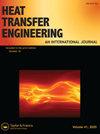Selected Papers from the 4th International Conference on Advances in Mechanical Engineering (ICAME2022)
IF 1.6
4区 工程技术
Q3 ENGINEERING, MECHANICAL
引用次数: 0
Abstract
"Selected Papers from the 4th International Conference on Advances in Mechanical Engineering (ICAME2022)." Heat Transfer Engineering, ahead-of-print(ahead-of-print), pp. 1–2 Disclosure statementThe authors declare there is no conflict of Interest at this study.Additional informationNotes on contributorsMarimuthu CheralathanMarimuthu Cheralathan is presently Professor and Head of the Department, Mechanical Engineering at SRM Institute of Science and Technology, Kattankulathur. He obtained his Ph.D. degree from Anna University, Chennai in 2007. He has three decades of experience in teaching and research. His area of interest includes thermal energy storage for heating and cooling applications, bio fuels and bio energy. He has published around ten patents and one has been granted. He has authored more than fifty articles in reputed journals. He is a member of SAE, SESI, IE(I), ISCA, and ISTE.Chandrasekaran SelvamChandrasekaran Selvam is an Assistant Professor at the Department of Mechanical Engineering, SRM Institute of Science and Technology, Chennai, India. He obtained his Doctorate from Anna University, Chennai, in nanofluid heat transfer. His research interests include enhancement of heat transfer using nanofluids, refrigeration and air-conditioning, thermal energy storage, thermal management of thermoelectric cooler and concentrated photovoltaics. He has published many articles in various reputed international journals.Ramalingam SenthilRamalingam Senthil is an Associate Professor at SRM Institute of Science and Technology, Chennai. He obtained his Ph.D. from the SRM Institute of Science and Technology. He has two decades of experience in teaching and research. He is working on solar energy conversion and storage technologies. He has delivered more than thirty expert talks on solar energy and thermal energy storage perspectives. He is a member of ISES, SESI, IE(I), IEEE, ISCA, and ISTE. He authored more than eighty articles in indexed (Scopus and Web of Science) journals. He is a reviewer in sixty-plus reputed international journals. Currently, he is featured in the Top 2% Most Cited Scientists in the World (Elsevier-Stanford University Report, Oct 2021).第四届国际机械工程进展会议(ICAME2022)论文选集
第四届国际机械工程进展会议(ICAME2022)论文选集。《热传导工程》,出版前1-2页。披露声明作者声明本研究不存在利益冲突。作者简介:marimuthu Cheralathan现任卡丹库拉图尔SRM科学技术学院机械工程系教授和系主任。他于2007年获得金奈安娜大学博士学位。他有三十年的教学和研究经验。他感兴趣的领域包括加热和冷却应用的热能储存,生物燃料和生物能源。他发表了大约十项专利,其中一项已经获得授权。他在知名期刊上发表了50多篇文章。他是SAE、SESI、IE(I)、ISCA和ISTE的成员。Chandrasekaran SelvamChandrasekaran Selvam是印度金奈SRM科学技术研究所机械工程系的助理教授。他在金奈安娜大学获得纳米流体传热博士学位。他的研究兴趣包括纳米流体强化传热、制冷与空调、热能储存、热电冷却器热管理和聚光光伏。他在各种国际知名期刊上发表了许多文章。Ramalingam Senthil,金奈SRM科学技术研究所副教授。他在SRM科学技术研究所获得博士学位。他有二十年的教学和研究经验。他正在研究太阳能转换和储存技术。他在太阳能和热能储存方面发表了三十多次专家演讲。他是ISES, SESI, IE(I), IEEE, ISCA和ISTE的成员。他在索引(Scopus和Web of Science)期刊上发表了80多篇文章。他是六十多家国际知名期刊的评论员。目前,他是世界上被引用最多的科学家的前2%(爱思唯尔-斯坦福大学报告,2021年10月)。
本文章由计算机程序翻译,如有差异,请以英文原文为准。
求助全文
约1分钟内获得全文
求助全文
来源期刊

Heat Transfer Engineering
工程技术-工程:机械
CiteScore
4.50
自引率
17.40%
发文量
111
审稿时长
7.5 months
期刊介绍:
Publishing 18 issues per year, Heat Transfer Engineering is an unparalleled resource for key advances in the field of heat transfer for the practicing engineer and other workers in the field. The journal publishes analytical, numerical, and experimental articles of lasting interest in the general area of heat-mass transfer and the related fluid mechanics and thermodynamics.
In a clear, easy-to-read format, the journal includes refereed papers of original work, state-of-the-art reviews, articles on new developments in equipment or practices, reviews of fundamentals, heat in history articles, book reviews, news items on people and companies in the field, advertising, and any other items that may be appropriate.
All submitted manuscripts are subject to initial appraisal by the Editor and/or selected members of the Editorial Board, and, if found suitable for further consideration, to peer review by independent, anonymous expert referees.
 求助内容:
求助内容: 应助结果提醒方式:
应助结果提醒方式:


